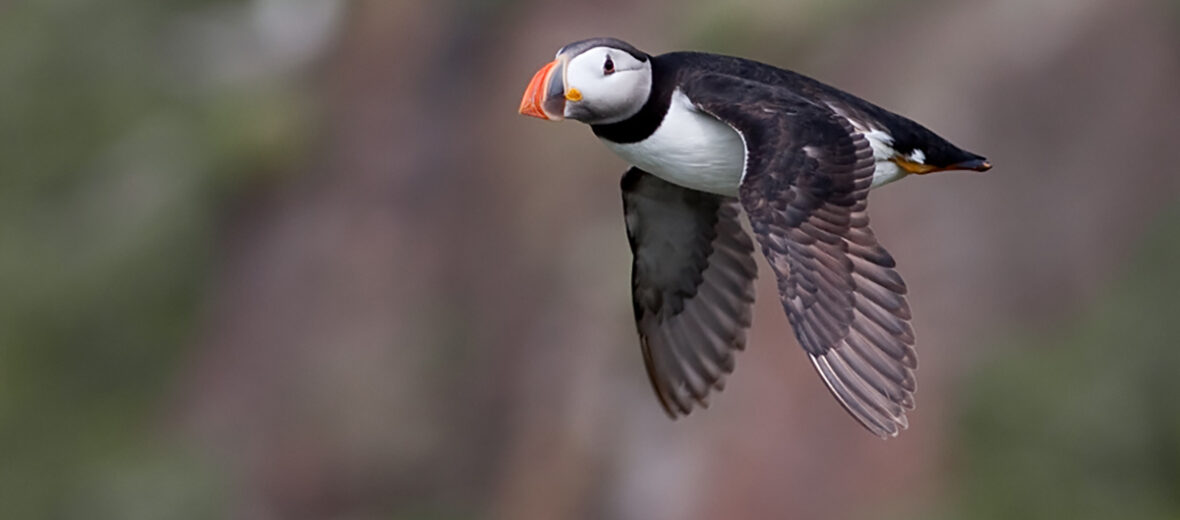
The Atlantic puffin, aka common puffin, is a member of the auk family. They are the only puffin native to the Atlantic Ocean. These sea birds are found along the coasts of United States, Iceland, Greenland, Europe, Russia, and Africa. Even though they have an estimated population of approximately 14,000,000, these birds are under the threats of renewable energy; hunting; trapping; disturbances by human recreational activities; invasive species, and with them predation, disease, and competition for food; and climate change, and with it temperature extremes and flooding, and are thus listed as Vulnerable by the IUCN.
First the Stats…
Scientific name: Fratercula arctica
Weight: Up to 1.1 lbs.
Length: Up to 8+ inches
Wingspan: Up to 25 inches
Lifespan: Up to 36 years
Now on to the Facts!
1.) Zooplankton, small fish, crabs, and shrimp are all on the menu for these piscivores (eat aquatic life).
2.) They catch their food by diving underwater and utilizing their wings for propulsion.
3.) In the winter, these birds will molt while at sea. In the spring they get their new coat and their colors return.
4.) These birds are sexually monomorphic (males and females look similar), except males are usually just a little larger than females.
5.) Puffins from northern populations are usually larger than in the ones in the south.
But wait, there’s more on the Atlantic puffin!
6.) Gulls and skuas are their primary predators. However, foxes, rats, stoats, weasels, cats, and dogs can also prey on these birds on land.
7.) Nests are built in clifftop colonies, and the nest is nothing more than a dug out burrow in the cliff face.
Did you know…?
Atlantic puffins can dive to depths of up to 200 feet, but can only hold their breath for up to 30 seconds.
8.) Females lay a single egg that hatches in up to 45 days.
9.) Chicks grow fast on a diet of mostly whole fish. In just 6 weeks, then leave the nest under the cover of night and make their way to the open sea.
10.) Once the chicks make their way to the open ocean, they don’t return to land for several years.
But wait, there’s still more on the Atlantic puffin!
11.) Due to their colorful beak, they have been colloquially known as clowns of the sea or sea parrots.
12.) Atlantic puffins are social birds that dwell and breed in large colonies.
Did you know…?
These puffins are the official bird of the Canadian provinces of Labrador and Newfoundland.
13.) When at sea, they bob on the water like a cork, moving themselves through the water with powerful thrusts of their feet and always keeping turned towards the wind, even when resting and supposedly sleeping.
14.) A fair amount of the day is spent preening their feathers with oil produced from their preen glands.
15.) These skillful critters are able to catch multiple fish on a single dive. They swallow the smaller ones and bring the larger ones to the surface to consume.
But wait, there’s still a little more on the Atlantic puffin!
16.) Dominance is displayed with an upright stance, and fluffed chest feathers, as well as a cocked tail, an exaggerated slow walk, head jerking, and gaping. The submissive birds lower their heads and hold their bodies horizontally and scurry past the dominant individuals.
17.) This show of dominance is usually displayed during mating season and when arriving on land to find the best spot to nest.
Did you know…?
In the Shetland Islands, sand eels typically make up at least 90% of the food fed to chicks. In times where the sand eel populations were low, the breeding success rates dropped significantly.
18.) New colonies are not very likely to start up sporadically because these gregarious birds only nest where others are already present. But you gotta start somewhere.
19.) Hunting areas at sea are usually up to 62 miles offshore.
20.) Adults bringing fish to their chicks usually arrive in large groups. This is thought to benefit them by reducing kleptoparasitism (stealing food from other animals) by skuas.
But wait, there’s still a tad more on the Atlantic puffin!
21.) SOS Puffin is a conservation project at the Scottish Seabird Centre at North Berwick to save the puffins on islands in the Firth of Forth.
22.) The Norwegian municipality of Værøy has an Atlantic puffin as it’s civic emblem.
23.) The publisher of paperbacks, Penguin Books®, introduced a range of books for children under the Puffin Books brand in 1939.
Now a Short Atlantic Puffin Video!
Be sure to share & comment below! Also, check out the Critter Science YouTube channel. Videos added regularly!
Want to suggest a critter for me to write about? Let me know here.
Some source material acquired from: Wikipedia & IUCN
Photo credit: Mark Medcalf



